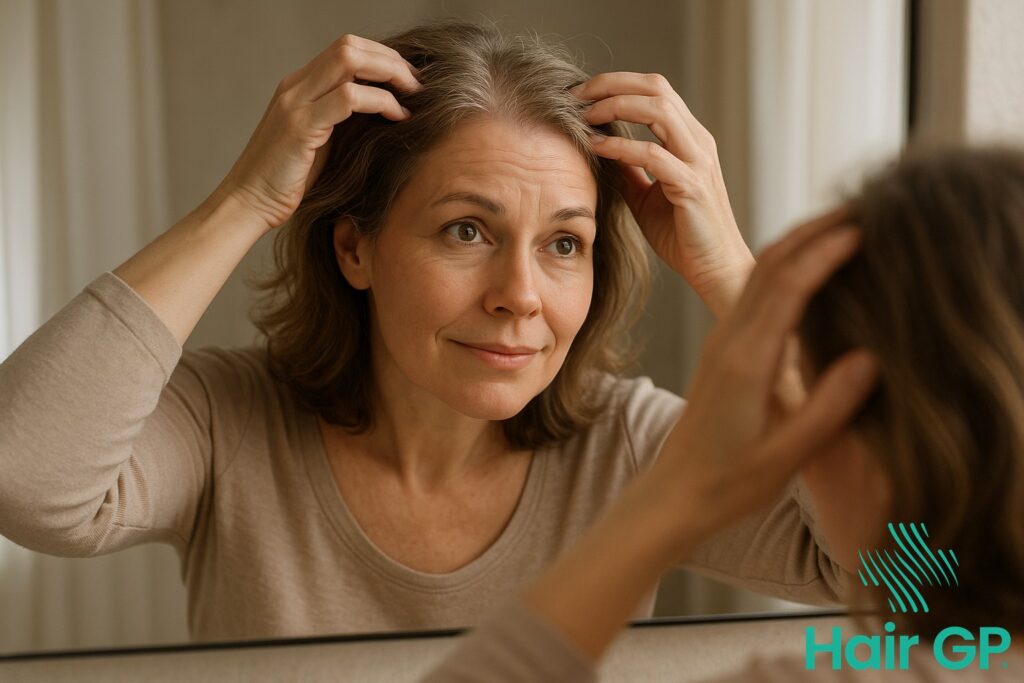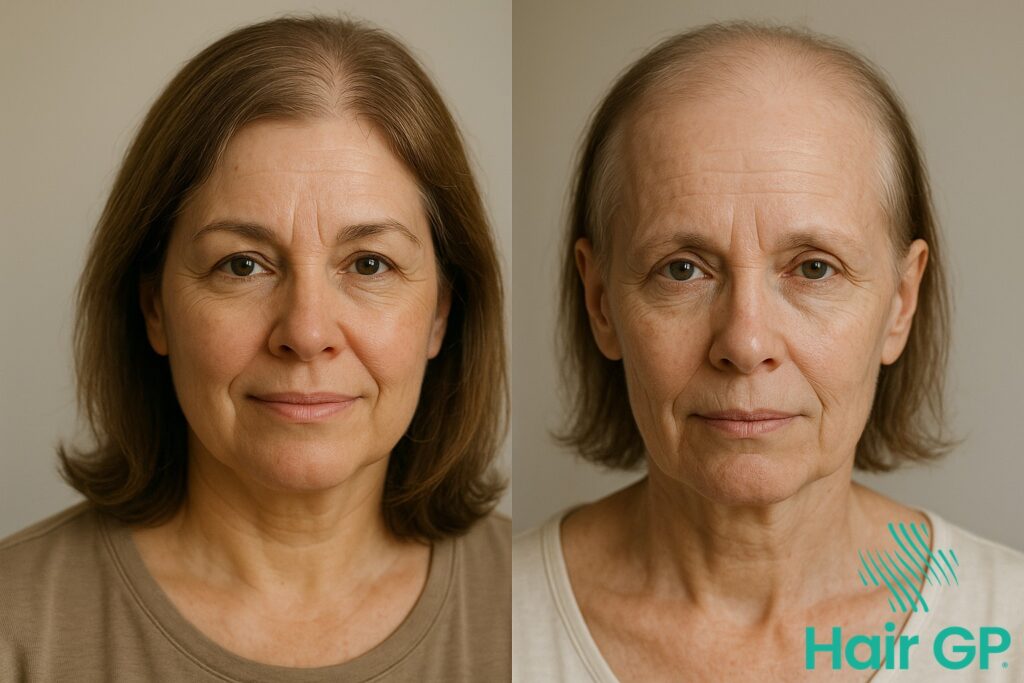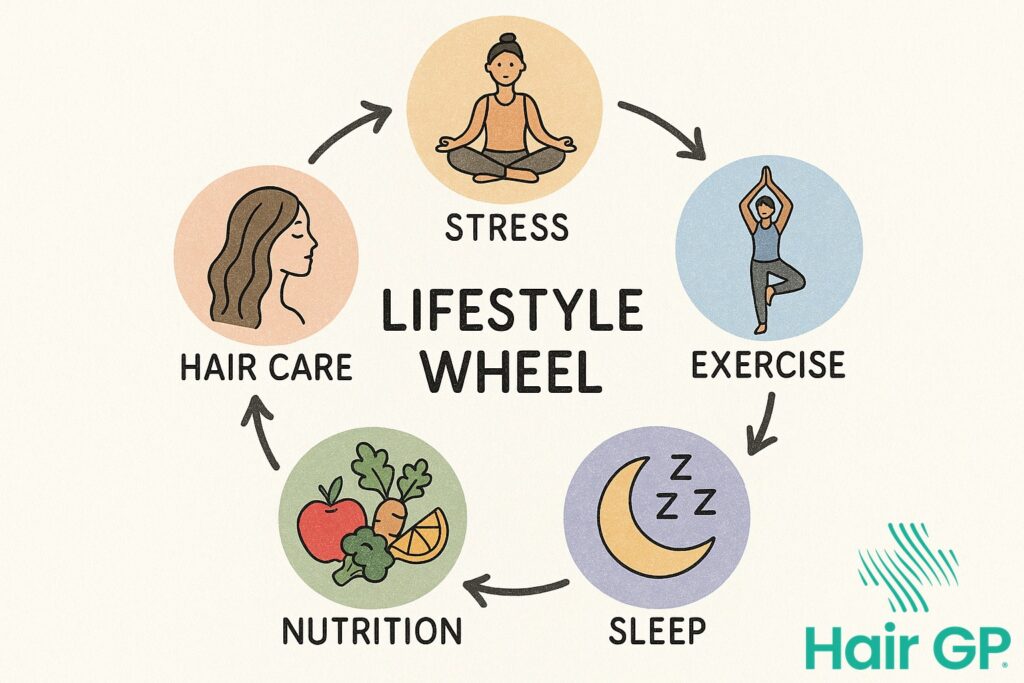Introduction
If you’ve noticed your once-thick hair feeling thinner, shedding more strands in the shower, or developing a different texture, you’re not alone. For countless women entering their 40s and 50s, these hair changes mark an unwelcome companion to perimenopause—the transitional period leading up to menopause when hormones begin their dramatic shift.
The connection between perimenopause and hair loss is far more than coincidental. As oestrogen levels fluctuate and eventually decline, your hair follicles respond to this hormonal shift in ways that can dramatically affect hair health. What many women don’t realise is that menopausal hair changes aren’t simply about ageing—they’re the direct result of complex biological processes that alter how your hair grows, rests, and sheds.
Understanding why these changes occur is the first step towards maintaining healthy hair during this transitional period. This comprehensive guide explores the intricate relationship between hormones and hair growth, helping you recognise the common patterns of hair thinning that affect women during perimenopause. We’ll examine the science behind hormonal hair loss, discuss how to identify different types of female pattern baldness, and explore both professional treatment options and practical at-home strategies. Most importantly, we’ll provide you with the knowledge and tools needed to take control of your hair health during this significant life transition, offering hope and practical solutions for maintaining beautiful, healthy hair throughout perimenopause and beyond.
Key Takeaways – TL/DR
- Hormonal fluctuations during perimenopause directly impact hair growth cycles and can cause noticeable thinning
- Female pattern hair loss affects up to 40% of women by age 50, often beginning during perimenopause
- Early intervention with proper hair care and professional treatments can help maintain hair density and health
- Lifestyle factors like nutrition, stress management, and scalp care play crucial roles in supporting healthy hair growth
Understanding Perimenopause and Its Impact on Hair
Perimenopause represents a critical transitional phase in a woman’s reproductive life, characterising the years leading up to menopause when hormonal fluctuations begin to significantly impact various aspects of health, including hair vitality. Understanding this connection between hormonal shift and hair changes helps explain why many women experience alterations in their hair’s thickness, texture, and overall appearance during this life stage.
What Happens During Perimenopause
Perimenopause typically begins in a woman’s 40s, with the average age of onset being 47 years, though it can start as early as the late 30s [1]. This transitional period lasts an average of four years, during which oestrogen levels fluctuate unpredictably before gradually declining. Unlike the steady hormonal patterns of younger years, perimenopause is characterised by erratic hormone surges and drops, creating an environment of hormonal instability that directly affects hair follicle health and the natural hair growth cycle.
How Hormones Affect Hair Growth
Oestrogen plays a crucial protective role in maintaining healthy hair by extending the growth phase of the hair growth cycle and supporting hair follicle health. When oestrogen levels decline during perimenopause, hair follicles lose this protective influence, leading to shorter growth phases and increased hair shedding [2]. Simultaneously, the relative increase in testosterone levels, combined with declining oestrogen, allows for greater conversion of testosterone to dihydrotestosterone (DHT). This potent hormone causes hair follicles to miniaturise, producing progressively thinner, weaker strands that characterise menopausal hair changes. The disruption of the normal hair growth cycle results in more hairs entering the shedding phase simultaneously, creating the noticeable hair thinning that many women experience during this hormonal transition.
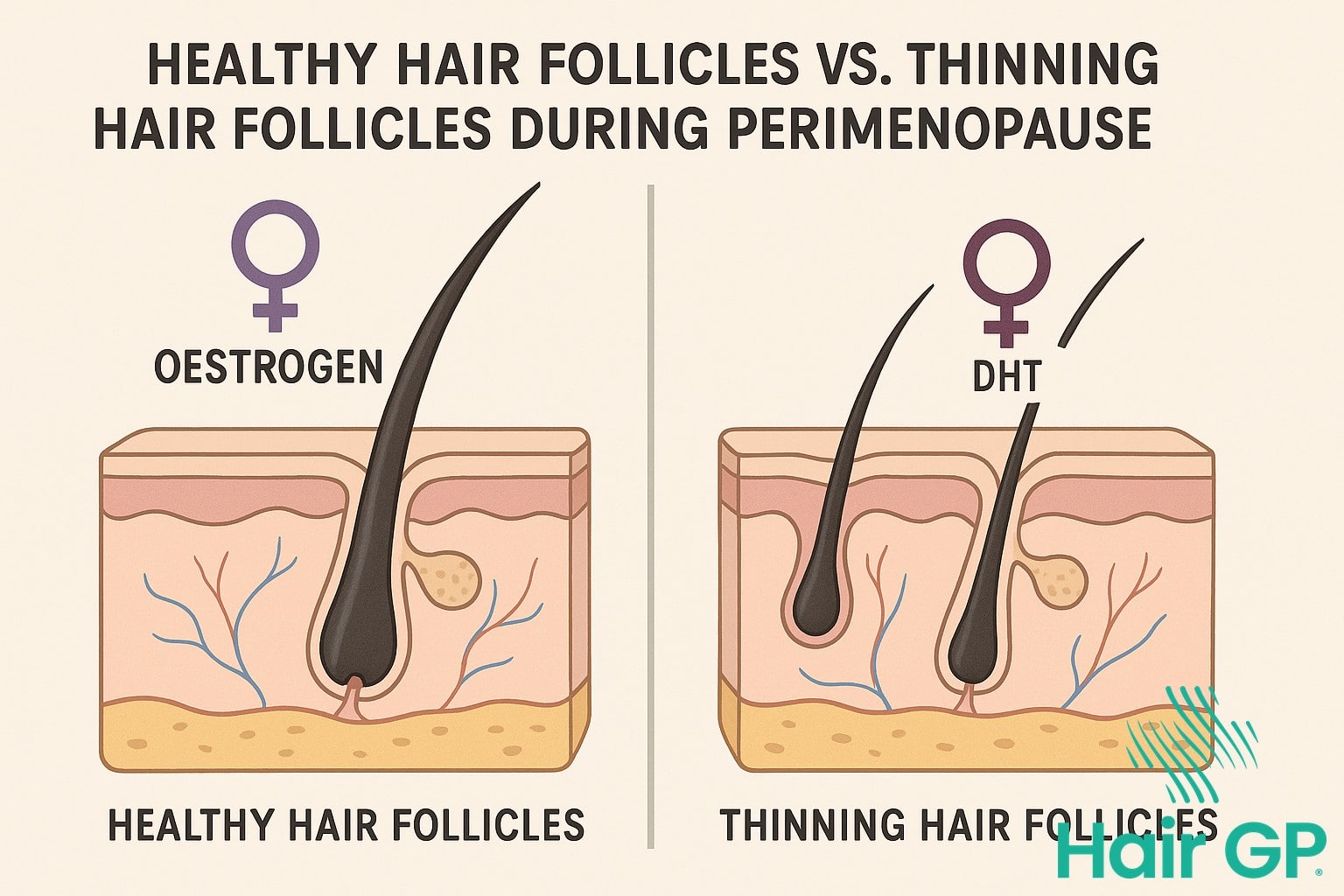
The Science Behind Hormonal Hair Loss
The biological mechanisms underlying hair loss during perimenopause involve complex hormonal interactions that disrupt normal hair follicle function. As women navigate this transitional period, declining oestrogen levels and increased sensitivity to androgens create a perfect storm for hair thinning and loss.
Oestrogen’s Protective Role
Oestrogen serves as a crucial guardian for hair follicle health, actively promoting the anagen (growth) phase of the hair growth cycle whilst protecting follicles from miniaturisation [3]. During reproductive years, adequate oestrogen levels maintain robust hair density by extending the growth phase, allowing individual hairs to reach their full length and thickness potential. However, as oestrogen production declines during perimenopause, this protective barrier weakens significantly. The reduction in oestrogen removes the natural defence against follicle shrinkage, leaving hair vulnerable to the damaging effects of androgens and ultimately contributing to female pattern hair loss.
DHT and Follicle Sensitivity
Dihydrotestosterone (DHT), the potent androgen responsible for androgenic alopecia, becomes increasingly problematic as hormonal balance shifts [4]. DHT forms when the enzyme 5-alpha reductase converts testosterone, and whilst women produce less testosterone than men, the declining oestrogen levels during menopause create a relative androgen excess. Hair follicles, particularly those in the crown and temples, contain androgen receptors that become hypersensitive to DHT during this hormonal transition. This increased sensitivity triggers a process called miniaturisation, where healthy follicles progressively shrink over successive hair cycles, producing increasingly fine, short hairs before eventually ceasing hair production entirely.
Disrupted Growth Cycles
The normal hair growth cycle consists of three distinct phases: anagen (growth), catagen (transition), and telogen (rest). Hormonal fluctuations during perimenopause severely disrupt this carefully orchestrated process, resulting in menopausal hair loss patterns. The anagen phase becomes significantly shortened, reducing the time available for hair growth and resulting in shorter, weaker strands. Simultaneously, the telogen phase extends beyond its normal duration, meaning more follicles remain dormant for longer periods. This disruption leads to increased daily hair shedding, with women often noticing more hair in their brush, shower drain, or on their pillow, as the natural balance between growing and resting follicles becomes severely compromised.
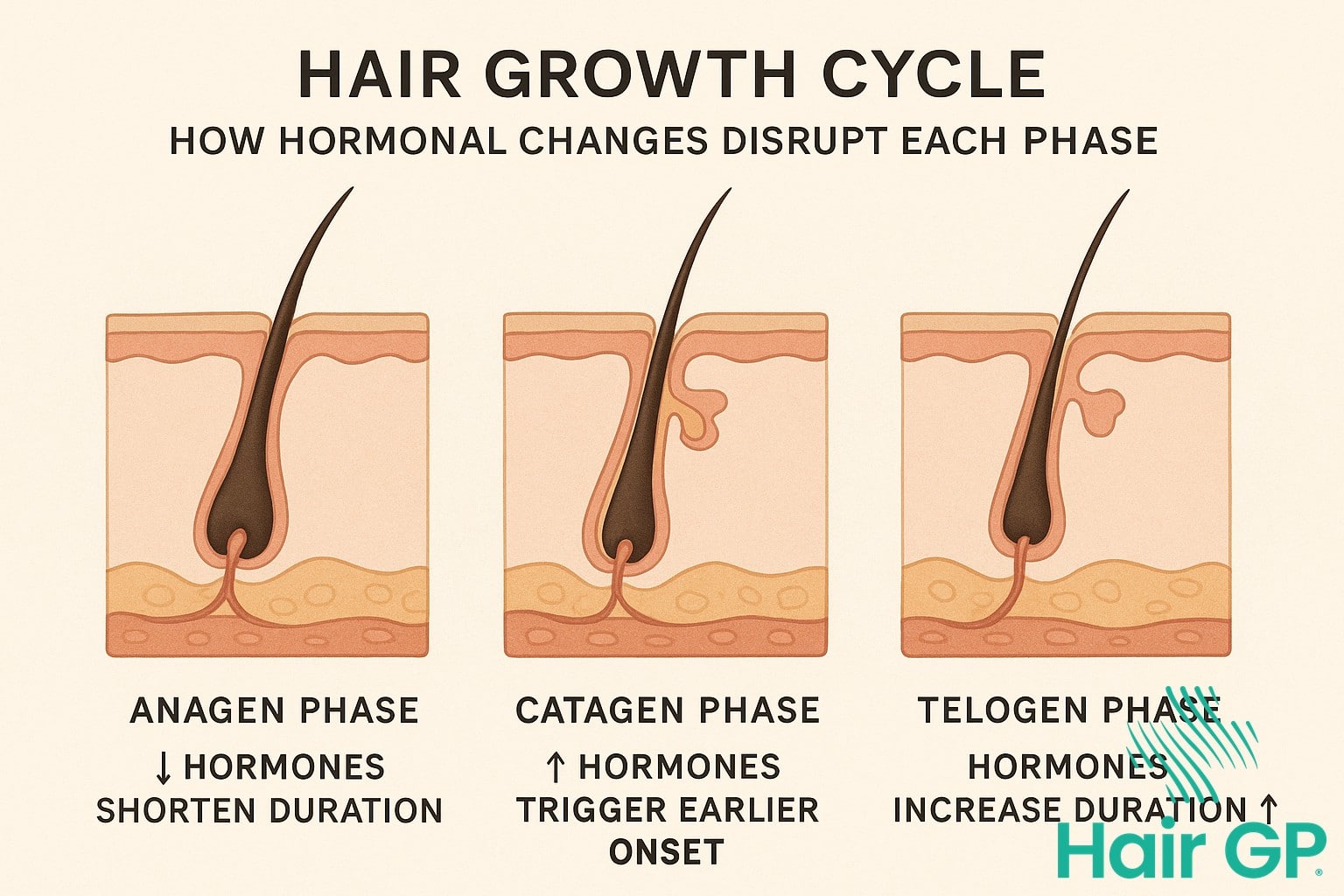
Common Hair Changes During Perimenopause
Perimenopause brings distinctive hair changes that many women notice gradually over time. These alterations can affect hair density, texture, and overall appearance, creating concerns about thinning hair and changes in hair quality that were previously unfamiliar.
Overall Hair Thinning
Hair thinning during perimenopause typically occurs as a diffuse pattern affecting the entire scalp rather than concentrated areas. Women often notice gradual hair density reduction, making the scalp more visible through their hair, particularly under bright lighting. The part line may appear wider than before, and ponytails or buns seem noticeably smaller in circumference. This overall thinning develops slowly, sometimes taking months or years to become apparent, which distinguishes it from sudden hair loss conditions.
Texture and Quality Changes
Hormonal fluctuations significantly impact hair structure, leading to increased fragility and changes in feel. Hair may become notably dry hair, losing its natural shine and appearing dull or lacklustre. Many women experience brittle hair that breaks more easily during brushing, styling, or even gentle handling. The texture itself may change, with some experiencing coarser strands whilst others find their hair becomes finer and more delicate than previously.
Increased Daily Shedding
Increased hair shedding becomes noticeable during daily activities like washing, brushing, or styling. Normal shedding typically ranges from 50-100 hairs daily, but perimenopausal women may observe significantly more hair in their brush, shower drain, or on pillows. Seasonal variations can intensify this pattern, with autumn months often bringing increased shedding. Concern is warranted when shedding dramatically exceeds normal amounts or occurs alongside sudden bald patches.
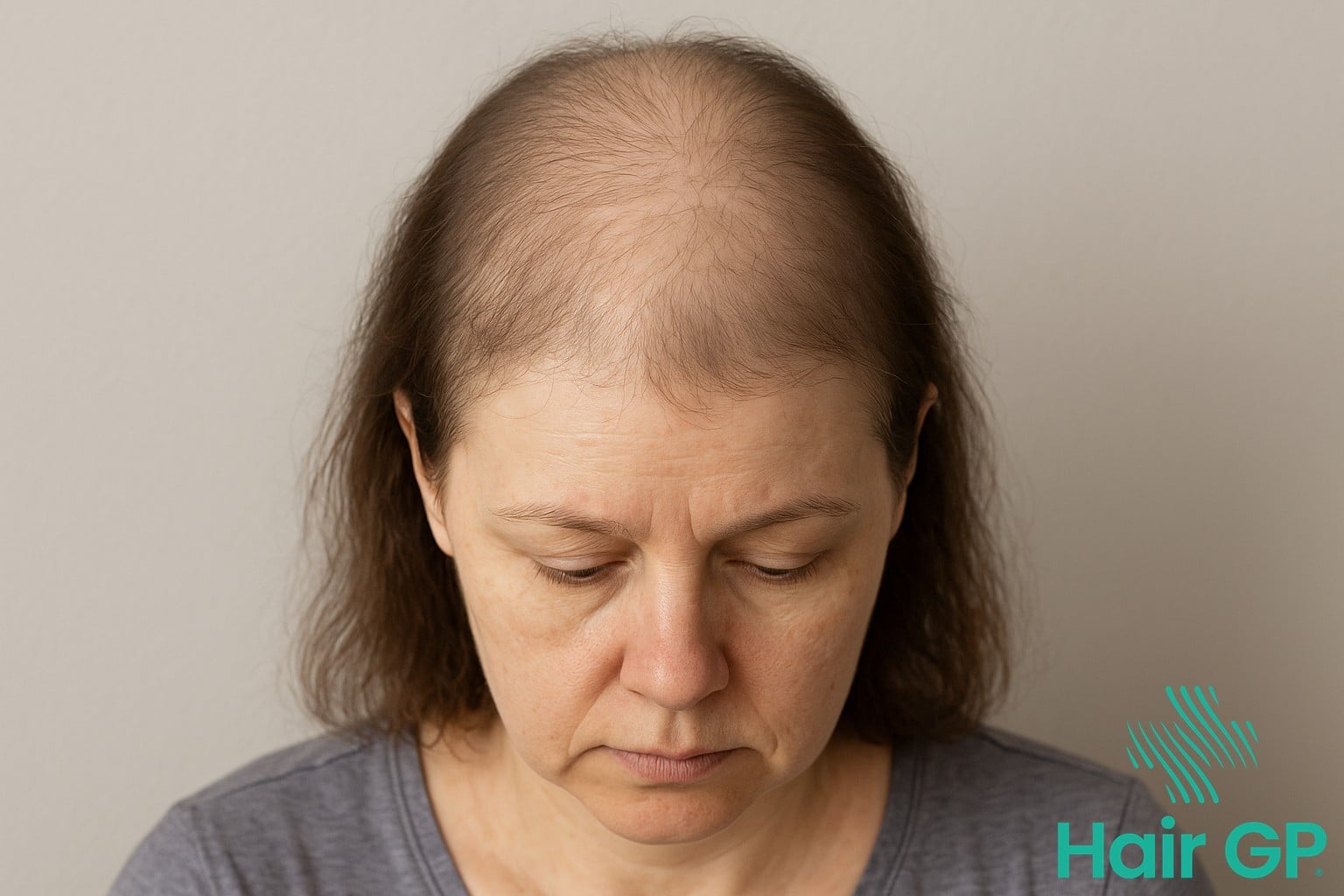
Identifying Female Pattern Hair Loss
Recognising female pattern hair loss requires understanding the distinctive characteristics that separate androgenetic alopecia from temporary hair shedding. Unlike sudden hair loss from stress or illness, female pattern hair loss develops gradually with specific patterns that become more pronounced over time, particularly affecting menopausal women who experience this condition at rates of approximately 40% by age 50[5].
Recognition Patterns
Female pattern hair loss typically manifests as diffuse thinning across the crown and vertex regions whilst preserving the frontal hairline. This androgenic alopecia pattern differs significantly from the receding hairlines seen in other forms of hair loss. The Ludwig and Savin classification systems help identify progression stages, with Ludwig Scale I showing mild crown thinning, Scale II demonstrating moderate diffuse loss, and Scale III revealing significant scalp visibility through thinned hair.
Key identification markers include gradual widening of the central parting, increased scalp visibility under bright lighting, and notably thinner ponytails. The hair loss pattern tends to be symmetrical and progressive, with individual hairs becoming finer and shorter over time. Unlike patchy alopecia areata, androgenetic alopecia presents as generalised thinning rather than distinct bald patches, making it sometimes challenging to detect in early stages.
When to Consult a Professional
Professional evaluation becomes essential when hair loss persists beyond three months or accelerates rapidly. Red flag symptoms warranting immediate consultation include sudden onset hair loss, scalp irritation, unusual hair loss patterns, or accompanying symptoms like fatigue or weight changes that might indicate underlying conditions.
Menopausal women experiencing progressive thinning should consider consulting a Specialist Hair Doctor within six months of noticing changes. Early intervention allows for accurate diagnosis through detailed examination, potential scalp biopsy, and blood tests to rule out other causes. Professional assessment can distinguish between androgenetic alopecia and other treatable conditions, enabling appropriate treatment strategies before significant hair loss occurs.
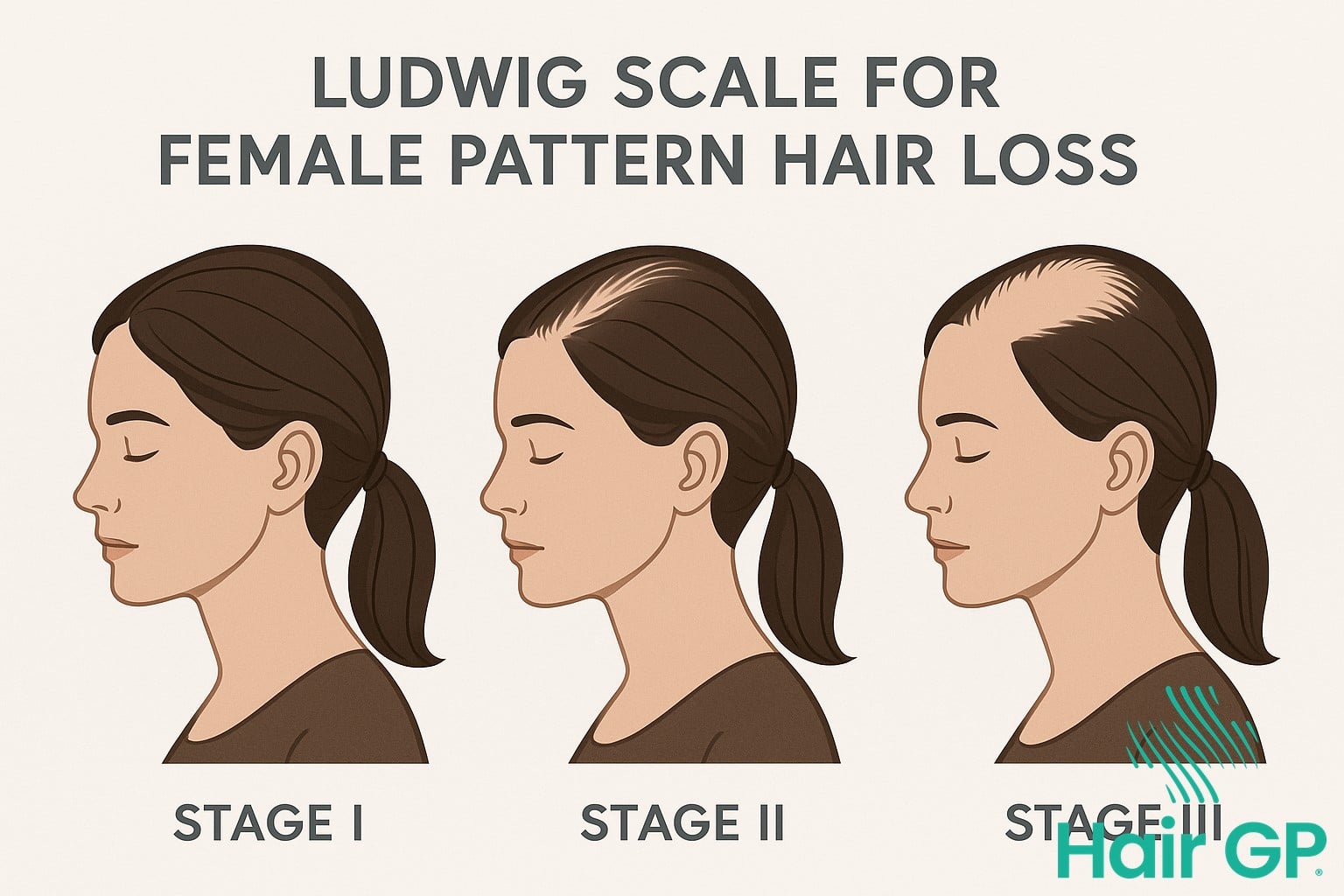
Professional Treatment Options
Perimenopausal women experiencing hair loss have access to several evidence-based professional treatments that can effectively combat hair loss and support hair growth. These treatments range from topical medications to hormonal interventions and advanced therapeutic procedures, each offering distinct benefits when administered under proper medical supervision.
Topical Medications
Minoxidil remains the gold standard hair loss treatment approved by regulatory authorities worldwide. This vasodilator works by increasing blood flow to hair follicles, extending the anagen growth phase, and helping to strengthen hair follicles over time. Clinical studies demonstrate that 5% minoxidil solution can significantly improve hair density in women with androgenetic alopecia, with approximately 60% of users experiencing measurable hair regrowth after 24 weeks of consistent application [6]. Women should apply minoxidil once daily to clean, dry scalp areas, with visible results typically emerging after 3-4 months of continuous use. A healthcare provider should monitor progress and adjust treatment protocols as needed.
Hormonal Interventions
Hormone replacement therapy (HRT) can provide substantial benefits for hair health during perimenopause by restoring oestrogen levels that naturally decline during this transition. Research indicates that HRT can improve hair thickness, reduce shedding, and support hair growth by counteracting the effects of declining oestrogen on hair follicles [7]. However, healthcare providers must carefully evaluate each patient’s medical history, as HRT carries potential risks including increased blood clot formation and certain cancers. Alternative hormonal approaches include selective oestrogen receptor modulators and bioidentical hormone preparations, which may offer similar hair benefits with potentially reduced risk profiles.
Advanced Procedures
Professional scalp treatments have evolved to include sophisticated options like platelet-rich plasma (PRP) therapy, which uses concentrated growth factors from the patient’s own blood to stimulate follicular regeneration. Low-level laser therapy provides another non-invasive option, using specific wavelengths to enhance cellular metabolism within hair follicles. Scalp micropigmentation offers a cosmetic solution for those seeking immediate visual improvement, creating the appearance of fuller hair density through specialised tattooing techniques. These treatments work best when combined with topical medications and under the guidance of experienced healthcare providers specialising in hair restoration.
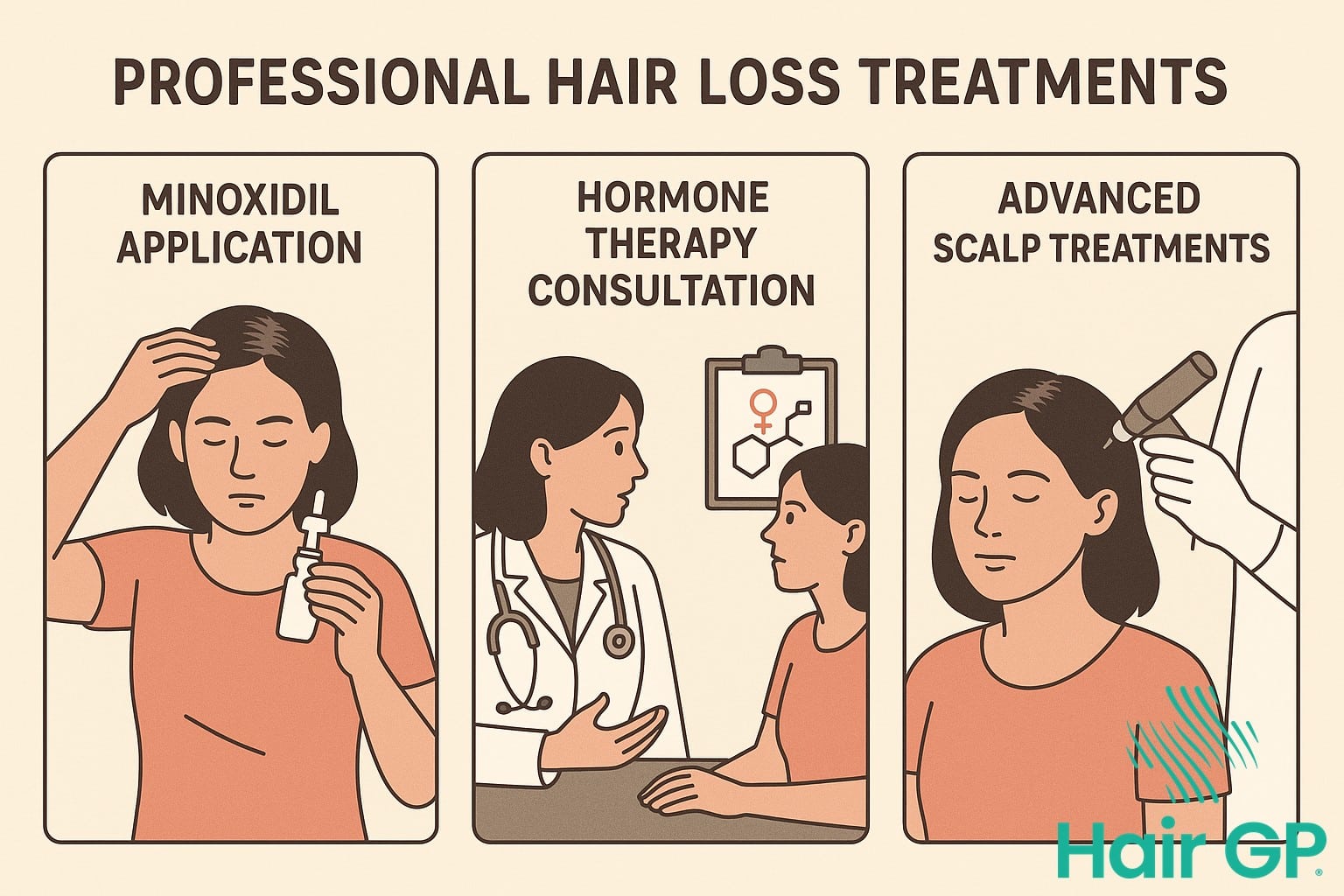
At-Home Hair Care Strategies
Implementing effective at-home hair care strategies provides immediate support for maintaining healthy hair during perimenopause. Simple adjustments to your daily hair care routine can significantly reduce breakage whilst promoting stronger, more resilient strands that support healthy hair growth.
Gentle Cleansing Routine
Establishing a gentle cleansing routine forms the foundation of effective hair care. Choose sulphate-free shampoos that cleanse without stripping natural oils, particularly beneficial for thinning hair. Wash every 2-3 days to prevent over-cleansing, which can compromise scalp health and exacerbate dryness. Apply conditioner from mid-length to ends, avoiding the roots to prevent weighing down fine hair. Use lukewarm water for washing, as hot water can damage the hair cuticle and irritate the scalp. Deep conditioning treatments once weekly provide additional moisture and strengthen the hair shaft.
Protective Styling
Protective styling techniques minimise mechanical damage whilst maintaining healthy hair appearance. Embrace low-heat styling by air-drying when possible or using heat protectant products before styling. When using heated tools, select the lowest effective temperature setting. Loose braids, gentle updos, and silk scrunchies reduce tension and breakage. Invest in silk or satin pillowcases to reduce friction during sleep, preventing tangles and hair breakage. Avoid tight ponytails and restrictive hairstyles that create tension on vulnerable areas. Regular trimming every 6-8 weeks removes split ends and maintains hair health.
Scalp Care and Massage
Prioritising scalp health creates optimal conditions for hair growth and overall hair care success. Regular scalp massage using fingertips stimulates blood circulation, promoting nutrient delivery to hair follicles. Incorporate 5-10 minutes of gentle circular motions during shampooing or as a standalone treatment. Essential oils like rosemary or peppermint, when diluted with carrier oils, may enhance circulation and provide therapeutic benefits. Keep the scalp clean and free from product buildup, which can clog follicles and impede growth. Gentle exfoliation using a soft brush removes dead skin cells and improves scalp health.
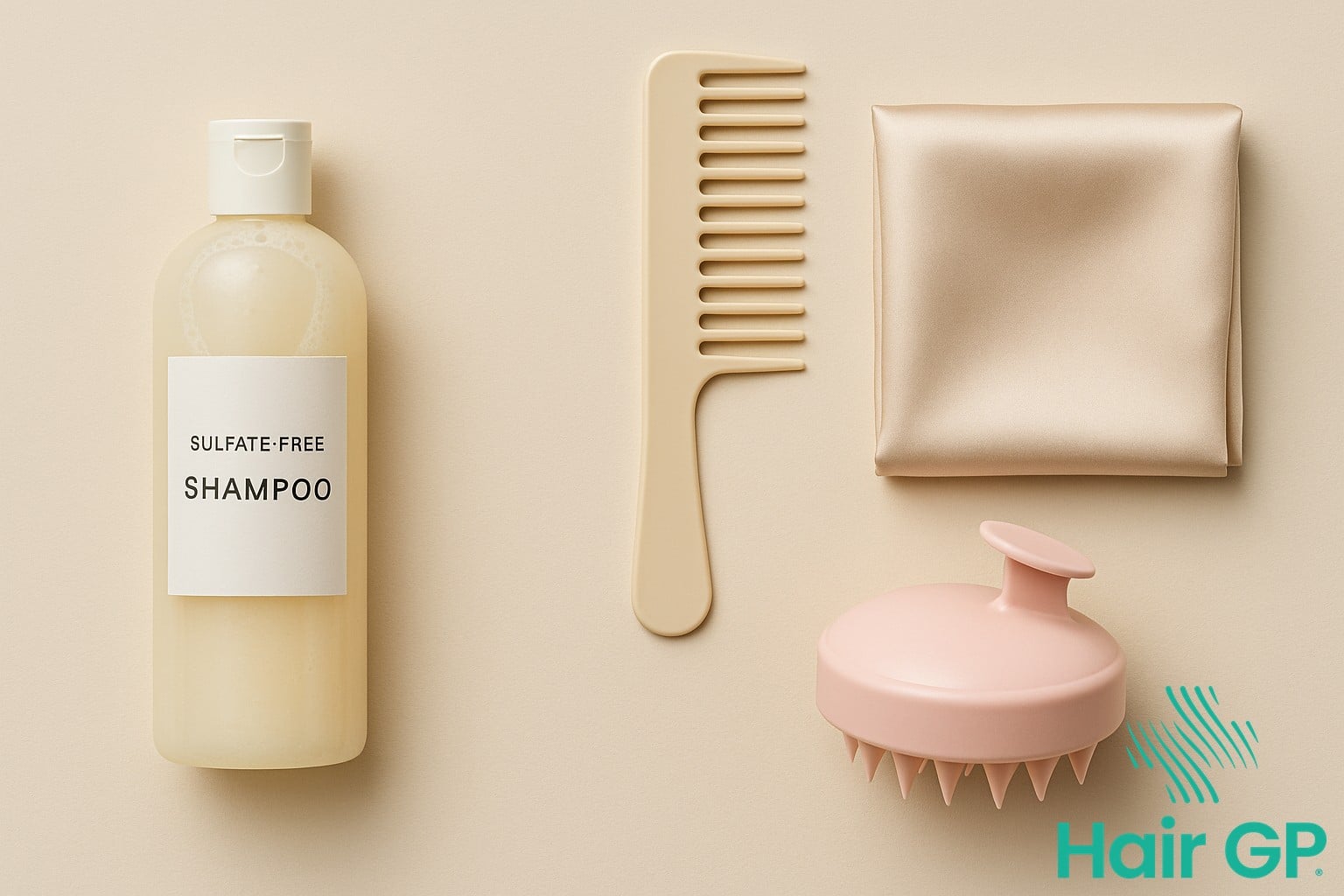
Conclusion
Understanding that perimenopausal hair changes are both common and treatable empowers women to take control of their hair health during this transitional period. The key to maintaining beautiful hair throughout perimenopause lies in recognising early warning signs and implementing appropriate interventions before significant changes occur.
Establishing a comprehensive hair care routine tailored to your changing needs can significantly impact healthy hair growth. This includes using gentle, hormone-balancing products, maintaining proper nutrition, and adopting stress management techniques that support overall hair health.
Consulting with a healthcare provider early in your perimenopausal journey enables personalised treatment strategies that address your specific concerns. Whether through hormone replacement therapy, targeted nutritional supplements, or specialised topical treatments, professional guidance ensures you receive the most effective interventions for your situation.
Remember that perimenopause affects every woman differently, and what works for others may not be suitable for you. By staying informed, maintaining open communication with healthcare professionals, and remaining patient with treatment outcomes, you can successfully navigate this phase whilst preserving your hair’s vitality and appearance.
The journey through perimenopause doesn’t have to mean sacrificing beautiful hair. With proper knowledge, proactive care, and professional support, you can maintain healthy, vibrant hair throughout this natural life transition.
Frequently Asked Questions
Perimenopausal hair changes typically begin 2-8 years before menopause and may continue for several years after. The timeline varies significantly between individuals, but most women notice stabilization within 2-3 years post-menopause with proper care and treatment.
While complete reversal may not always be possible, many women can significantly improve their hair density and health with early intervention. Professional treatments like minoxidil, combined with proper hair care and lifestyle changes, can help restore much of the lost volume.
Yes, increased hair shedding is common during perimenopause due to hormonal fluctuations. However, losing more than 100-150 hairs daily consistently, or noticing significant thinning, warrants professional evaluation to rule out other causes.
You don’t need to avoid hair coloring entirely, but choose gentler formulations and reduce frequency. Ammonia-free colors, professional application, and deep conditioning treatments can help maintain hair health while managing color changes.
References
- Grymowicz M, Rudnicka E, Podfigurna A, et al. Hormonal Effects on Hair Follicles. Int J Mol Sci. 2020;21(15):5342.
- Piraccini BM, Alessandrini A. Androgenetic alopecia. G Ital Dermatol Venereol. 2014;149(1):15-24.
- Bolduc C, Shapiro J. Female pattern hair loss: current treatment concepts. Dermatol Clin. 2016;34(2):119-131.
- Kanti V, Messenger A, Dobos G, et al. Evidence-based (S3) guideline for the treatment of androgenetic alopecia in women and in men – short version. J Eur Acad Dermatol Venereol. 2021;35(11):2112-2125.
- Ramos PM, Miot HA. Female Pattern Hair Loss: a clinical and pathophysiological review. An Bras Dermatol. 2015;90(4):529-543.
- Lucky AW, Piacquadio DJ, Ditre CM, et al. A randomized, placebo-controlled trial of 5% and 2% topical minoxidil solutions in the treatment of female pattern hair loss. J Am Acad Dermatol. 2004;50(4):541-553.
- Phillips TG, Slomiany WP, Allison R. Hair Loss: Common Causes and Treatment. Am Fam Physician. 2017;96(6):371-378.

